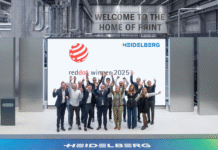New Delhi-based Shree Sai Labels which installed a 6- color Mark Andy 2200 in 2010, added an 8-color MA 2200 two months ago to meet the high demand for labels. Vikash Kumar, the proprietor of Shree Sai is a veteran who started his career at Interlabels. After working with several large organized label producers, Kumar started out on his own as he felt there was an opportunity to improve customer service.
Customers need close interaction
“Some ofthe top label companies only gave good service to the large multinational brands and neglected the medium range companies who were also interested to grow and automate operations. As a marketing person I soon realized that selling labels was more like a service industry instead of a product industry. We needed to work closely with our small and medium customers at every stage from designing labels to the development and applicationofthe final product,” says Kumar.
This was clearly something that many label companies were unwilling to do as they were structured more like a product delivery organization. Another major issue says Kumar,
was that in earlier days, label companies mainly located in Western India failed to service the demand of the Delhi NCR region companies that were experiencing phenomenal
growth. Sensing the opportunity, in 2007 Kumar set off on his own, and started his firm Shree Sai Labels for trading of labels in New Delhi.
Kumar focussed on the pesticide, pharma and chemical industries initially, with organized players whose business volumes were lower than the FMCG majors who were getting all
the attention of the large label companies. “Most of our customers like Bayer,Glaxo andPfizer and smaller companies in these segments were using manually produced labels those days and getting contract workers to paste them. We took the initiative and helped them to develop high quality labels producedinautomaticmachines that had lesser rejection andmore outputperday.”As business volumes grewrapidly Kumar beganto expand and startedmeeting the demands of other segments such as food, beverages, liquor, cosmetics and FMCG.
Industry shakeout a possibility
In 2010, when the growth of the label industry was at its peak, Kumar decided to setuphis ownflexographic label press andchose theMA2200 fromMarkAndywith rewinding and slitting machines from RK Machines of Ahmedabad. “We were producing 80,000 to 100,000 square metres of labels each month in those days and the margins were good with demand far outstripping supply,” says Kumar. The subsequent years saw a rapid build-up of label printing capacity across India and a consequent erosion of margins, says Kumar.
Seventy percent of the work done at Shree Sai Labels is in the metallized labels segment. Since its client base is intact and the demand for metallized labels is increasing it is putting up a second 8-color MA 2200 label press with an online inspection system, de-lamination and re-lamination, movable cold stamping and hot stamping, and a print onbackside facility. “Wehope to raise the production oflabels to 1.8 lakh square metres each month before the end of the year,” says Kumar. “The label industry would see some shakeout in the near future with localized consolidation of capacities,” says Kumar. “The label is not a final product and frequently changes to suitthedeliveryneeds ofthe customer, so only theywillprosperwho can meet local demands with a lean hierarchy and quick response times.”












